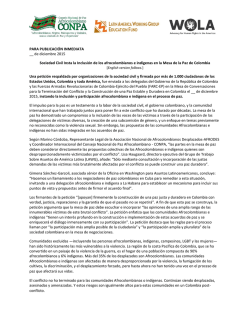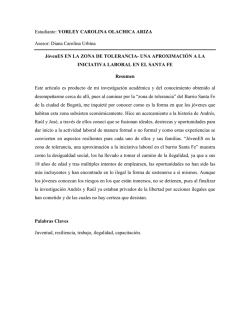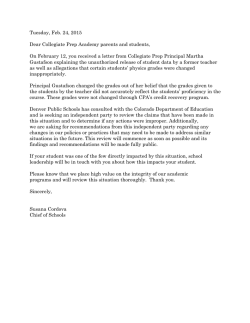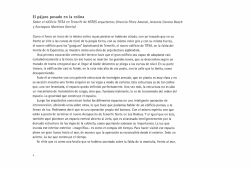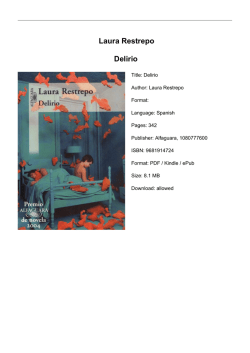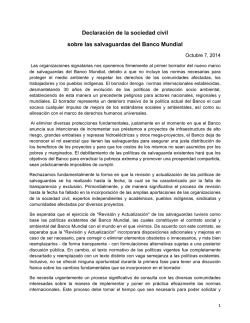
Los cinco puntos cardinales en la literatura indígena
Dialogo An Interdisciplinary Studies Journal Published by the Center for Latino Research at DePaul University Volume 19 Number 1 Spring 2016 2320 North Kenmore Avenue Schmitt Academic Center, 5A-H Chicago, Illinois 60614-3250 Tel:773-325-7316 Fax:773-325-7166 E-mail:[email protected] Web:http://las.depaul.edu/centers-and-institutes/center-for-latino-research Copyright © 2016 Center for Latino Research at DePaul University. Diálogo is published with support from DePaul University’s College of Liberal Arts and Social Sciences and the Office of the Provost. Diálogo is a refereed journal published since 1996 (biannually since 2012) by the Center for Latino Research at DePaul University in Chicago. Diálogo seeks research articles of regional and national contexts with focus on diverse Latin American and U.S. Latino populations and experiences, recent immigration and places of origin, including indigenous experience. We welcome submissions throughout the year: articles that help bridge barriers between academic and local communities, book and film/media reviews, and interviews pertinent to Latino communities in the U.S., the Caribbean, and Latin America. Published in Spring and Fall, often calls are issued for special themes. Cover: José Ismael Manco Parra, Raíces de la tierra, carbón vegetal y tintes vegetales sobre lienzo, 2.05 mts x 1.12 mts, 2014 Photography, artwork, and other visual material included throughout are used with permission. No part of Diálogo may be reprinted, reproduced, or transmitted in any form, beyond what is acceptable according to the Fair Use Policy, without written permission from the Diálogo editorial office. Send requests for permission to [email protected]. ISSN 1090-4972. All Rights Reserved. Diálogo An Interdisciplinary Studies Journal Published by the Center for Latino Research at DePaul University Volume 19 Number 1 Spring 2016 The Five Cardinal Points in Contemporary Indigenous Literature Travel (el viaje) | Water (el agua) | Fire (el fuego) | Earth (la tierra) | Air (el aire) Los cinco puntos cardinales en la literatura indígena contemporánea Guest Thematic Editors: Gloria E. Chacón and Juan Guillermo Sánchez Martínez EDITOR Elizabeth Coonrod Martínez ASSISTANT EDITOR Cristina Rodríguez POETRY & CREATIVE EDITOR Juana Iris Goergen BOOK & FILM REVIEW EDITOR Bill Johnson González EDITORIAL CONSULTING BOARD Gabriela Baeza Ventura, University of Houston Norma E. Cantú, University of Missouri, Kansas City Rafael Chabrán, Whittier College Hilda Chacón, Nazareth College Arlene Dávila, New York University Gilda Ochoa, Pomona College Kim Potowski, University of Illinois at Chicago Luis Escala Rabadán, Colegio de la Frontera Norte María de los Ángeles Torres, University of Illinois at Chicago CLR-DEPAUL ADVISORY BOARD Rocío Ferreira, Modern Languages Department Juana Iris Goergen, Modern Languages Department Bill Johnson González, English Department Megan Bernal, University Library OFFICE MANAGER Chelsea Díaz STUDENT STAFF Brenda E. Becerra Paulina Nava Jaime Ochoa Andrea Ortiz COPY EDITING SERVICES Ben Levitt PRESS Corporate Graphics of America, Inc. Diálogo An Interdisciplinary Studies Journal Published by the Center for Latino Research at DePaul University Volume 19 Number 1 Spring 2016 FROM THE EDITOR A New Century for Indigenous Writing Elizabeth Coonrod Martínez 2 FROM THE GUEST THEMATIC EDITORS Coordenadas nativo-migrantes Juan Guillermo Sánchez Martínez 3 Indigenous Literatures and Epistemologies: The Ordering of the Ancient Word in the Contemporary World Gloria E. Chacón ARTICLES Indigenous Women’s Rivered Refusals in El Calaboz Margo Tamez 5 7 Precious Water, Priceless Words: Fluidity and Mayan Experience on the Guatemalan-Belizean Border Jennifer Carolina Gómez Menjívar 23 Telling Stories, Being Places: Indigenous Ontologies in Guyana Katherine MacDonald 33 La conjuración de la Madre: Sobre la traducción de un texto de Anastasia Candre Juan Alvaro Echeverri 47 Dɨona uai, komuiya reikɨ: Palabra de tabaco y fuego de vida entre los murui-muina Laura Tattiana Areiza Serna 61 El uso material e inmaterial del fuego en el pueblo originario Kaggaba de la Sierra Nevada de Santa Marta Leidy Johanna Pinto García 71 Poetas y escritoras mayas de Guatemala: Del silencio a la palabra Maya Cú 81 Contemporary Expressions of Maya Indigenous Knowledge: Politics and Poetry in Ixim Ulew Vivian Jiménez Estrada 89 A Poetics of Weaving in the Work of Humberto Ak’abal Rita M. Palacios 105 Resistance through Revision in Javier Castellanos Martínez’s Cantares de los vientos primerizos Abbey Poffenberger 119 La literatura mapuche actual y su tránsito hacia una etapa nacional: Perrimontun de Maribel Mora Curriao Mabel García Barrera 137 REFLECTIONS/REFLEXIONES A Testimony Before the United Nations Sinangan Si Craig Santos Perez 153 (Is There) An Indigenous Literature? Yasnaya Elena Aguilar Gil 157 Una historia de los sikuris en Bogotá Daniel Castelblanco 161 INTERVIEW Una aproximación a la obra de Javier Castellanos Martínez en el marco de la literatura zapoteca contemporánea: Reflexiones, inquietudes y pláticas Anna M. Brígido-Corachán 175 ABOUT THE ARTIST El arte de José Ismael Manco Parra 184 RINCON CREATIVO Yomu’muli and the Talking Tree Jon M. Fox 185 Los sueños de Kitiar Maria Clara Sharupi Jua 189 Variaciones Uagibler Cebaldo de León 191 Manan imanarunpaschu Fredy Amílcar Roncalla 193 Ti guiichi/ Una espina/ Thorn Ni cudxi’badu/ La siembra/ Sowing Irma Pineda 195 K’uubul k’aaba’, La entrega del nombre Jorge Miguel Cocom Pech 199 La Goldcorp Inc. Daniel Caño 201 Tü türeinkat matüjainsalü ashawalawaa/ El tren no sabe detenerse Poloosü pütchi/ Diez palabras Rafael Mercado Epieyu 203 Ik’ (luna) Ixkik Clara Alicia Sen Sipac 207 Donimähets’i/ Flor del cielo Rä nanijä’i/ Hombre vagabundo Jaime Chávez Marcos 209 Ja’alil/ Otoño Síibal/ Dádiva Eek’jo’och’eenil/ Oscuridad Marisol Ceh Moo 211 Poema sin título Poema sin título Rosa Chávez 213 Loq’neem/ Ternura No’jb’al/ Sabiduría ancestral Kaypa’ Pascual Felipe Tz’ikin 214 Rebozo/ Rebozo Muskuy/ Sueño Mushuk nina/ Fuego nuevo Kintikuna/ Colibríes Lucila Lema 215 Xch’ultesel/ Ceremonia Ch’in ach’ix ants soke/ Niña-mujer zoque Armando Sánchez Gómez 217 Beso Di Manigueuigdinapi Jorge Stanley Icaza 219 Tlahtocani incitlalhuan/ Sembrador de las estrellas Ximotlapalilia tetlazohteotzin/ Pinta dador de vida Pedro Martínez Escamilla 221 Milpa/ Awan Calixta Gabriel Xiquín 223 BOOK REVIEWS Apu Kolki Hirka, Dios montaña de plata por Macedonio Villafán Broncano Ulises Juan Zevallos-Aguilar 225 Tell Me the Story of How I Conquered You: Elsewheres and Ethnosuicide in the Colonial Mesoamerican World by José Rabasa Samantha K. Fox 227 Red Skin, White Masks: Rejecting the Colonial Politics of Recognition by Glen Coulthard Jorge E. Cuéllar 229 Ch’akulal, chuq’aib’il chuqa b’anobäl: Mayab’ ixoqui’ chi ru pam jun kaxlan tz’apatäl tijonïk. Cuerpos, poderes y políticas: Mujeres mayas en un internado católico por Emma Chirix Morna Macleod 231 Rhythms of the Pachakuti. Indigenous Uprisings and State Power in Bolivia by Raquel Gutiérrez Aguilar Philipp Altmann 233 Two-Spirit Acts: Queer Indigenous Performances by Jean O’Hara Rudi Kraeher 235 The Red Land to the South: American Indian Literature and Indigenous Mexico by James H. Cox Paulina M. Gonzales 237 An Indigenous Peoples’ History of the United States by Roxanne Dunbar-Ortiz Matthew J. Irwin 239 Place and Identity in Classic Maya Narratives by Alexandre Tokovinine Paul Worley 241 Diné Perspectives: Revitalizing and Reclaiming Navajo Thought edited by Lloyd L. Lee Amanda R. Tachine and Jeston Morris 243 Hawansuyo Ukun Words por Fredy Amílcar Roncalla Juan Guillermo Sánchez Martínez 245 Teorizando las literaturas indígenas contemporáneas by Emilio del Valle Escalante Rita M. Palacios 247 CONTRIBUTORS 249 ANNOUNCEMENTS 253 CALL FOR ARTICLES 254 SUBMISSION GUIDELINES 255 SUBSCRIBE TO Diálogo 256 A New Century for Indigenous Writing Elizabeth Coonrod Martínez DePaul University T his issue has been a delight to prepare, from the keen intelligence and heartfelt approach of the Guest Thematic Editors in collecting and designing the theme, to the intricate research and innovative writing of the contributors. Diálogo 19:1 is also a little longer than usual, in order to embark on a hemispheric inclusion of contemporary American (continent) Indigenous production. Each article is a great pleasure to read! Significantly, this issue helps us re-think “Latin” America by bringing to light the long negated histories, philosophy, knowledge, resistance and presence of the original peoples of the Americas. Our university students can react with surprise upon hearing that even today in cities Indigenous peoples are expected to step aside and give the right-of-way to any non-Indigenous passer-by, or that a common response to “let’s go” is: deja ponerme los zapatos pa’ que no piensen que soy india (wait, let me put my shoes on so they don’t think I’m an Indian). While these examples are shocking to students in the U.S., English language and custom has similar derogatory cultural sayings or views of “Indians.” Even Indigenous words have less value than Spanish or English. For example, a friend’s name is Xochitl (beautiful Náhuatl word for flower): when she was about to be baptized (in Mexico City) however, the priest declared that it was “not a Christian name,” and had to be changed. Her mother replied, “ok, Xochitl Magdalena,” and he said that would work. But her mother never put the second name on the birth certificate, a little act of resistance toward the imposed system in this hemisphere. These examples demonstrate that contemporary institutional systems which regulate our societies need change. This unique collection reveals the powerful work of Indigenous scholars, creative and scientific writers. The authors bring focus to regions from Mesoamerica to the Andes to the Amazons, and the southern U.S. While these regions were invaded by Spanish, British and U.S. forces, the new hegemonies did not succeed in eradicating the orientation/philosophies and languages of Native peoples. The imposition of the system and Diálogo cultural factors of Western civilization dismissed and denied this hemisphere’s own system of thought and approaches to knowledge. The articles in this issue will demonstrate how millennial philosophies and knowledge are passed on, the continuity of various languages and practices, and the interrelationship between peoples and their environment. Some approaches take us on journeys to regions invisible to contemporary societies, others are tenderly evocative, and others reveal little-recognized aspects of science and history. A few recent actions open a path for the future: In Canada, just since the Fall of 2015, some educational systems are instituting a requirement of Indigenous studies courses. In 2014, from the federal chambers of both Canada and Australia, elected politicians issued formal apologies to Indigenous peoples for removing children to internment schools (from the late 19th to the early and mid-20th century) where they were stripped of cultural practices and languages, and often punished and abused. In the U.S. Northwest, and due to some activities in the middle of the country, several cities and two states advocated for and instituted renaming the federal observance of “Columbus” day to Indigenous Peoples Day. Last year in Alaska—after two years of public protests, followed by major consensus among elected officials—the governor signed into law House Bill 216, officially establishing 20 Alaska Native languages, making it only the second U.S. state to do so, after Hawaii. A possible influence and major factor for Latin America in terms of re-addressing official histories and understanding of Indigenous presence was the United Nations Declaration on the Rights of Indigenous Peoples in 2007, affirming that Indigenous peoples are equal to all other peoples, and should be respected as such. A resolution adopted by the General Assembly—144 nations in favor, and four nations against (Australia, Canada, New Zealand and the U.S.)—emphasizes the need for recognition and respect for Indigenous knowledge, cultures and practices, and welcomes the fact that Indigenous peoples “are organizing themselves for political, economic, From the Editor 1 Elizabeth Coonrod Martínez social and cultural enhancement to bring to an end all forms of discrimination and oppression.”1 A permanent forum endeavors to preserve and revitalize Indigenous languages; and in 2015 a second “International Decade of the World’s Indigenous Peoples” was formally launched, with several new projects underway. Efforts by people around the world engaging with each other are still, however, diminutive against the giant force of the more powerful nations which do not budge (see, for example, the article by Craig Santos Pérez). The 21st century is an era of new awakening. Scholarship over the past two decades is making strides in reviewing buried colonial records and revaluing the hemisphere’s original orientation, the cultural and historic legacies of American Indigenous peoples. In the U.S.—where languages were greatly lost due to the constant push to eradicate them, including rounding up and separating Indigenous children from their parents, to place in boarding schools where abuse was practiced, their Native languages prohibited, and their names changed to Anglo-origin names—a new phenomenon is evident in books published by historians and literary scholars, and notably, by American Indian writers. Some of these books are described in the extensive book review section of this issue. The articles in this magnificent issue can help with teaching and enlightenment. New Indigenous production guides us to an understanding of ancient philosophies and wisdom. Indigenous philosophy and knowledge (for their libraries and books, were destroyed) is equal to that of the Greeks, an observation made by one of my students. Far from trivialized, this hemisphere’s orientation should be respected in the same manner as that of Western Civilization. With a balance of articles in Spanish and English, including excerpts in Indigenous languages, the richly diverse and extensive histories of many regions are reviewed. Even the special comics section, following the articles, dispels erroneous notions and relates the teachings of the grandfathers and grandmothers. It is not easy to dislodge popular concepts perpetuated since the early colonial systems but, through teaching, and reading of Native texts, awareness and learning is acquired. Beginning with the first article in this collection, on the Texas border region (where Indian land was never legally ceded by Indigenous peoples, simply invaded), this issue will help readers explore Native knowledge and 2 From the Editor Volume 19 Number 1 Spring 2016 ways of preservation, making present histories rendered invisible long ago. May you reap new awareness from these readings. Saludos cordiales desde Chicago. NOTE 1 See <http://www.un.org/esa/socdev/unpfii/documents/ DRIPS_en.pdf> SPECIAL ANNOUNCEMENT As we were moving to galleys and layout of this issue, we were notified of the selection of Diálogo for the 2015 Phoenix Award for Significant Editorial Achievement. The Council of Editors of Learned Journals (CELJ) issues this award annually for “journals that have launched an overall effort of revitalization or transformation within the previous 3 years.” The committee considers both content and subject matter, as well as design and structure. This is a great honor. Diálogo Coordenadas nativo-migrantes Juan Guillermo Sánchez Martínez West Virginia University Los puntos cardinales son cinco. Es usted, aquí, el quinto punto cardinal. Humberto Ak’abal, Los cinco puntos cardinales L o que en la última década del siglo XX se llamó “el despertar de la nueva palabra” (Miguel León-Portilla, Carlos Montemayor, Natalio Hernández) principalmente en México, y que creció paralelo a la Oralitura (Chihuailaf, Chikangana, Cocom, Jamioy) la cual llegaba desde encuentros en el Sur, hoy en día sobrepasa cualquier intento de definir un movimiento o fenómeno (ver la reflección aquí incluida “(Is There) An Indigenous Literature?” de Yaxnaya Aguilar). La diversidad de estilos y los múltiples intereses (a veces contradictorios) de los autores y autoras (actualmente de diversas generaciones), ha enriquecido esta producción que, como se verá, es la vanguardia hoy tanto en la escritura creativa como en la investigación. La experimentación lingüística, el esfuerzo por explorar otras ontologías desde la intermitencia de códigos, el saber holístico que trenza ciencia, arte y espiritualidad, son solo algunos rasgos que están removiendo hoy las literaturas canónicas en inglés, español y francés. De igual forma, la lectura desde conceptos provenientes de las lenguas y ontologías nativas (ver los artículos de Margo Tamez, Vivian Jiménez, Laura Areiza, Johanna Pinto, Mabel García y Rita Palacios, así como los estudios de Abbey Poffenberger y Anna Brígido-Corachán sobre la obra de Javier Castellanos) es hoy reto para las humanidades, quienes hasta hace poco ofrecían definiciones unívocas para autor, escritura, cultura o literatura. ¿Por qué, entonces, “cinco puntos cardinales”? Esa fue la pregunta que nos hizo el mayor Yoeme Jon M. Fox cuando estábamos invitando a poetas y escritores a participar en este número. Nos explicó que él hablaba de Diálogo siete puntos según las enseñanzas en su comunidad: las cuatro direcciones, el zenit, el nadir y el centro. Gloria Chacón y yo sabíamos de las siete direcciones porque es un número que se repite en muchas cosmovisiones tanto de la Isla Tortuga como del Abya-Yala. También lo teníamos presente por nuestra propia experiencia con el cholq’ij (el calendario ritual maya). No obstante, habíamos decidido – en mi parte siguiendo el gesto creativo de Ak’abal– incluir en la idea del viaje, del desplazamiento, de la migración, el zenit, el nadir y el centro. Jon, sin duda, había tocado capas más profundas de la conversación, pues este número especial de la revista Diálogo no solo es una reflexión académica sobre “los puntos cardinales” o “los cuatro elementos”, sino un acercamiento a otros modos de entender el espacio, el tiempo y la palabra. Tanto en el ‘etehoi (cuento Yoeme sobre “Yomu’muli y el árbol que habla”) que Jon compartió para la revista, como en cada uno de los artículos, poemas, cuentos y reflexiones incluidos aquí, el lector apreciará la gravedad de los cinco rumbos. Cuando estábamos terminando de editar el número, Fredy Amílcar Roncalla, escritor quechua de la diáspora andina, nos contó que él había ideado la palabra Hawansuyo para nombrar estas literaturas que hacen parte (suyo) desde afuera (Hawan); Hawansuyo es otro modo de nombrar el quinto suyo, ese “archipiélago transandino” adentro/afuera de los Andes. No es casual, pues, que cada uno de los autores que aquí se han dado cita, dialoguen adentro/afuera de sus propios territorios en ese quinto punto cardinal de migraciones literarias e intercambios culturales. Sus textos repiten en distintas lenguas nativas y en español e inglés que el fuego, la tierra, el agua y el From the Guest Thematic Editors 3 Juan Guillermo Sánchez Martínez aire son memoria y medicina, son padres y madres que aclaran el camino del hombre y de la mujer. Como era de esperarse, las coordenadas que señalan estos textos están desbaratando los puntos cardinales de la mirada imperial, desnudando la ingenuidad de los estereotipos coloniales que asociaban la creación indígena a lo autóctono, local, tradicional, aislado, a lo exclusivamente oral. ¿Cuáles son las coordenadas hoy? ¿Cuáles los caminos en estos tiempos en que antiguas rutas de intercambio se están recobrando y re-creando? Al tejer los artículos y textos creativos aquí reunidos, estas son siete pistas: 1) a raíz de festivales internacionales de escritores, de antologías trans-indígenas (como este número de Diálogo), y de comunidades virtuales transnacionales como Hawansuyo, hay hoy una conciencia de luchas políticas e intereses estéticos compartidos entre escritores, investigadores, y movimientos sociales provenientes de diversas naciones indígenas (ver las reseñas sobre los libros de Emilio del Valle, Raquel Gutiérrez Aguilar, y James H. Cox), lo cual ha facilitado redes de apoyo, y proyectos culturales y espirituales (ver el testimonio/ poema de Craig Santos); 2) en esta apertura de diálogo ético y estético global, los pilares que sostienen las cosmovisiones locales se han fortalecido en tanto han encontrado eco en ontologías hermanas, cuyo principio general concibe la naturaleza no como un “recurso natural” sino como madre/padre de la existencia, relative, fuente del conocimiento y medicina, y con quien tenemos responsabilidades cotidianas y rituales (“La conjuración de la madre” de Anastasia Candre, traducida y comentada por Juan Álvaro Echeverri, es sin duda un texto único en esta coordenada); 3) en este escenario de tensiones entre lo global y lo local (ver la obra de Cebaldo de León) sobresalen dos tendencias entre creadores e investigadores (Allen 2012): los que apoyan un nacionalismo indígena, y los que se mueven entre distintas tradiciones, tejiendo puentes interculturales y trans-indígenas; 4) como protagonistas de la resistencia y como pilares y cargadoras de la tradición, las escritoras y poetas han creado un corpus literario único en las últimas dos décadas (ver la reseña al trabajo de Emma Chirix), el cual en muchos casos cuestiona el doble patriarcado (de la sociedad nacional, y de los hombres de su propia nación indígena – ver el artículo de Maya Cu) en el que han tenido que urdir sus obras (sin haberlo planeado, de 4 From the Guest Thematic Editors Volume 19 Number 1 Spring 2016 los once artículos, las tres reflexiones y la entrevista que reunimos aquí, sólo tres investigadores son hombres); 5) paralelo a la producción literaria y académica, otros creadores al interior mismo de los pueblos, los resguardos, las reservas, y en la frontera entre la ciudad y el territorio ancestral (ver el corpus de Margo Tamez, Laura Areiza, Johanna Pinto, Katie McDonald y Juan A. Echeverri), también han continuado enriqueciendo, salvaguardando y reinterpretando cantos, juegos de palabras, adivinanzas, lenguajes ceremoniales, discursos, leyes de origen, cartografías, todas palabras y signos con un alto grado de sofisticación semántica, así como de estructuras rítmicas y rituales específicas, las cuales nos invitan a otros modos de conocer; 6) como Tamez y su estudio sobre el “Big Water Country” Ndé entre Texas y Tamaulipas, y como Fox y su ‘etehoi sobre el sagrado río Yaqui entre Sonora y New México, así Carolina Gómez Menjívar mira hacia otra frontera (Belize River / Río Viejo) poco visitada por los lectores de la literatura “latinoamericana”. Desafiando los muros y las fronteras nacionales, el estudio comparado de estas literaturas devela historias compartidas que fortalecen las luchas del presente y la solidaridad del mañana; 7) finalmente, más allá de las teorías y los discursos académicos, cientos de jóvenes tanto en nuestros países latinoamericanos como en las grandes ciudades de los Estados Unidos y Canadá, están descolonizando su memoria a través del viaje al encuentro con mayores, médicos tradicionales, músicos, y cantores (ver las propuestas de Johanna Pinto y Laura Areiza, así como el cómic de Daniel Castelblanco y los dibujos del artista Ismael Manco), tejiendo textos colectivos para reconstruir antiguas rutas y narrar sus propias experiencias identitarias. Por lo demás, gracias a todas las autoras y autores que aceptaron nuestra invitación; gracias por compartir su saber y regalarnos su paciencia en esta construcción colectiva. Gracias, por supuesto, a Gloria Chacón, a Elizabeth Martínez y a Cristina Rodríguez por su apoyo incondicional editando los manuscritos que nos llegaban desde los cinco rumbos. Gracias al lector por asomarse a estas páginas, con las que espero que salte muros y cree puentes. Diálogo Indigenous Literatures and Epistemologies: The Ordering of the Ancient Word in the Contemporary World Gloria E. Chacón University of California-San Diego I n 1985, Angel Rama, one of the most respected and influential Latin American theorists to this day wrote that it made him uncomfortable to think of indigenous literatures as being first in literary histories because, he argued, “indigenous literatures are a product of European culture about existing materials…”(26). Particularly for indigenous peoples in Latin America, a continuous colonialist narrative that seeks to separate orality from literacy resuscitates a pernicious, developmentalist teleology around indigenous cultural productions. The popular adage in Latin America, “indio leido, indio perdido,” or what may be loosely translated as a “well-read Indian is a lost Indian” supports Hegel’s premise that the alphabet was that of civilized peoples. To be an indigenous writer and intellectual in Latin America continues to be seen as an anomaly—one that gets continually challenged by Indigenous writers and other intellectuals. This special issue provocatively titled, “The Five Cardinal Points of Indigenous Literatures,” germinated from a bold attempt to illustrate the rich potential and critical role indigenous literature—understood here in its broadest sense as words and images— plays in resisting continued indigenous dispossession not only materially, but in the realms of world politics, economies, epistemology. It occurred to us that a call for articles and creative works thematizing the persistence of indigenous epistemologies manifested in ways of conceiving and ordering the word/world could prove decisive in raising consciousness about the distinct issues facing contemporary first nations or pueblos originarios from how to preserve and maintain languages to how to retool narrative forms to innovate. Historically, the invocation and imbrication of the five elements and five directions appear recorded across many pre-Columbian sources, including ornaments, codices, and other surfaces. Their use in ceremony, prayer, song, nourishes indigenous poets in building of knowledge that seeks to invigorate an indigenous poetics. We invoke Q’anjobal scholar and poet Pedro Gaspar González Diálogo theoretical contribution, “kotz’ib,” which translates to “our writing.” Conceptually capacious, the term references alphabetic and hieroglyphic writings, textiles, ceramics, and oral traditions (6-7). The essays selected move from the cosmogonic and spiritual relationships indigenous peoples maintain with certain elements like fire, earth, water, and air to issues of political territories, migration, war, assimilation and resistance. Unlike many Latin/o American texts that have been characterized as a search for identity, Indigenous literatures represent an affirmation of identity, nations, languages, and cultural practices. The first three essays challenge nation-state formations in the United States, Central America, and South America. They stress the importance of storytelling, land, indigenous ontologies and remembering as relational manifestations. The opening essay, “Indigenous Women’s Rivered Refusals in El Calaboz,” by Margo Tamez (Ndé) unsettles nationstate borders in the Texas-Río Grande border through an indigenous episteme Tamez terms as “a rivering of memory.” Rivering of memory structures relational spheres among peoples. Rivering becomes a spatialized, political, cultural, and socio-economic reference. Tamez weaves storytelling, poetry, and pictographs to privilege indigenous epistemologies against an ongoing dispossession in the borderlands. In “Precious Water, Priceless Words: Fluidity and Mayan Experience on the Guatemalan-Belizean border,” Jennifer Gómez foregrounds an original analysis of a Mayan novel written by David Ruiz Puga to discuss the oversight of Mayan people from Belize in discussions of indigeneity in the isthmus. Centering the element of water represented by the Río Viejo/Belize River, Gómez broaches questions of naming, identifying the various linguistic registers, colonial differences, and borderland disputes that traverse understandings and relations among indigenous peoples, Kryoles, and mestizos. Katie MacDonald’s essay, “Telling Stories, Being Places” underlines the importance of storytelling and the element of earth as political territory manifested by the Rupununi in Guyana. Moving from From the Guest Thematic Editors 5 Gloria E. Chacón creation stories as cartographies of knowledge to how territory shapes people, the essay situates the metaphoric and symbolic function of mother earth. The second thematic set of essays are all in Spanish. This was not a linguistic decision; rather, they made sense together as they grapple with the element of fire, spiritual and material nourishment. Juan Alvaro Echeverri’s text situates the work of an important healer and poet Anastasia Candre. He analyzes Candre’s posthumous text, articulating the fundamental roles of spiritual and material sustenance to indigenous communities. He discusses gendered notions of knowledge that have nothing to do with Western conceptions of sexual roles. Laura T. Areiza Serna’s essay offers an insightful discussion of fire, tobacco, coca and yuka as key spiritual and material provisions for the Murui-Muna Jitómagaro (sun) clans. Leidy Johanna Pinto’s “El uso material e inmaterial del fuego en el pueblo originario Kaggaba de la sierra Nevada de Santa Marta” situates her essay as someone who was trained in Western Philosophy, and in her ignorance saw indigenous peoples as savages. She came to realize that much of the philosophy of the indigenous peoples in Santa Marta continued in the oral tradition. Through these narratives, a philosophy of fire as God is palpable. She, too, references the gendered dimensions of knowledge and spiritual practices of the Kaggaba in Colombia. Maya Cú’s personal essay offers her take on the rise of Maya or indigenous as a qualifier for literature. Cú’s perspective serves as a fitting transition to the emergence of the indigenous author as part and parcel of political movements in Mexico, Central America and South America. The next set of essays focus on the material, cultural artifacts gesturing towards the element of air, the breath that gives words life and meaning. Vivian Jimenez’s essay “Contemporary Expressions of Maya Indigenous Knowledge” focuses on Maya Cú’s poetry to discuss the survivance—to use Vizenor’s term—of Maya knowledge. Rita Palacios’s “A poetics of weaving” discusses how the K’iche’ poet, Humberto Ak’abal, re-signifies hegemonic, nationalist notions of the “traje típico” and weaving as a feminine practice in his poems by constructing his own ars poetica as a weaver of words. Abbey Poffenberger’s essay “Resistance Through Revision” analyzes the first Zapotec novel, “Cantares de los vientos primerizos/Songs of the first Winds” to broach the linguistic endangerment and the socio-political complexity faced by indigenous peoples in Oaxaca. Mabel 6 From the Guest Thematic Editors Volume 19 Number 1 Spring 2016 García’s essay concludes this component of the special issue; she features the heterogeneous projects by Mapuche cultural workers in Chile, establishing connections to territory, cosmopolitics, and language. The shorter pieces represent other provocations dealing with image and words (Daniel Castelblanco), a questioning of indigenous literature as a field (Yaxnaya Aguilar, Mixe intellectual), and Craig Santos’s testimony to the United Nations about the ongoing militarization of Chamorro territory. Santo’s piece unequivocally establishes a strong connection to poetry as political practice. Anna Corachán’s interview with Javier Castellanos Martínez offers insight into the life and work of Mexico’s first Zapotec novelist. All of the excellent book reviews included contribute to the fluidity of indigenous literature, history, and politics across continents. Critical essays addressing Native American literature in the United States remain wanting in this special issue, mainly due to the over-commitment of people who had expressed interest in contributing, but we hope that this lacunae serves as another provocation for future special issues. The creative section represents the different aesthetic projects that thrive in our continent. Finally, while this special issue makes overtures to the emerging discourse of Abya-Yala, as it calls for an indigenous intellectual autonomy, we are mindful that indigenous peoples have different terms in their own languages to name the continent, often times linked to particular socio-political, cultural and cosmogonic narratives. Naming and enunciating from a politics of location are critical to self-determination. We also recognize the importance of thinking relationally, transnationally, and in translation. It is not an accident that this special issue found a home in Diálogo, a Latino Studies Journal. Native American and Indigenous Studies have much to offer to Latino Studies and vice versa. It is a dialogue that is in some ways long over due. Literature has the privilege and task of preserving and continuing indigenous knowledge. In that spirit, we hope that this special issue serves as a springboard for other projects where literature and self-determination can be read across indigenous texts, nations, and languages. I want to thank my co-editor Juan Sánchez for his collaborative spirit, Elizabeth Martinez and Cristina Rodriguez for believing in this special issue from the start. Last but not least, my gratitude to all the contributors for their important work. Ch’ajb’e’yx. Diálogo
© Copyright 2025
